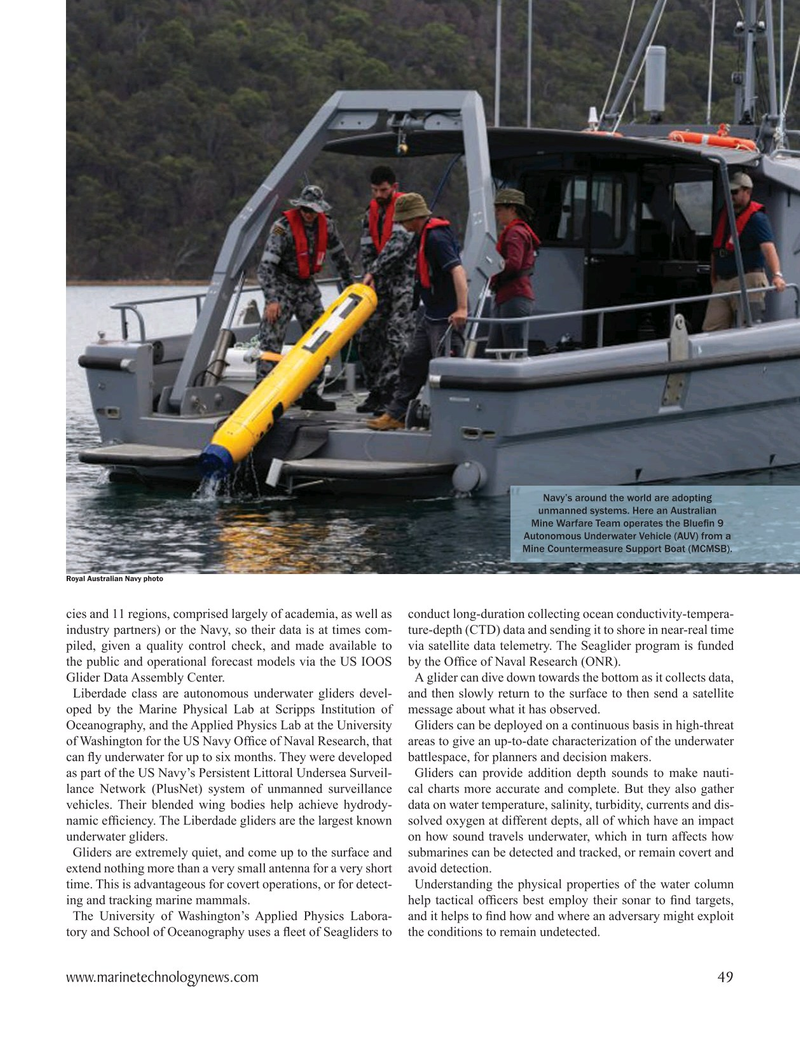
Page 49: of Marine Technology Magazine (January 2021)
Underwater Vehicle Annual
Read this page in Pdf, Flash or Html5 edition of January 2021 Marine Technology Magazine
Navy’s around the world are adopting unmanned systems. Here an Australian
Mine Warfare Team operates the Blue? n 9
Autonomous Underwater Vehicle (AUV) from a
Mine Countermeasure Support Boat (MCMSB).
Royal Australian Navy photo cies and 11 regions, comprised largely of academia, as well as conduct long-duration collecting ocean conductivity-tempera- industry partners) or the Navy, so their data is at times com- ture-depth (CTD) data and sending it to shore in near-real time piled, given a quality control check, and made available to via satellite data telemetry. The Seaglider program is funded the public and operational forecast models via the US IOOS by the Of? ce of Naval Research (ONR).
Glider Data Assembly Center. A glider can dive down towards the bottom as it collects data,
Liberdade class are autonomous underwater gliders devel- and then slowly return to the surface to then send a satellite oped by the Marine Physical Lab at Scripps Institution of message about what it has observed.
Oceanography, and the Applied Physics Lab at the University Gliders can be deployed on a continuous basis in high-threat of Washington for the US Navy Of? ce of Naval Research, that areas to give an up-to-date characterization of the underwater can ? y underwater for up to six months. They were developed battlespace, for planners and decision makers.
as part of the US Navy’s Persistent Littoral Undersea Surveil- Gliders can provide addition depth sounds to make nauti- lance Network (PlusNet) system of unmanned surveillance cal charts more accurate and complete. But they also gather vehicles. Their blended wing bodies help achieve hydrody- data on water temperature, salinity, turbidity, currents and dis- namic ef? ciency. The Liberdade gliders are the largest known solved oxygen at different depts, all of which have an impact underwater gliders. on how sound travels underwater, which in turn affects how
Gliders are extremely quiet, and come up to the surface and submarines can be detected and tracked, or remain covert and extend nothing more than a very small antenna for a very short avoid detection.
time. This is advantageous for covert operations, or for detect- Understanding the physical properties of the water column ing and tracking marine mammals. help tactical of? cers best employ their sonar to ? nd targets,
The University of Washington’s Applied Physics Labora- and it helps to ? nd how and where an adversary might exploit tory and School of Oceanography uses a ? eet of Seagliders to the conditions to remain undetected.
www.marinetechnologynews.com 49
MTR #1 (34-49).indd 49 1/25/2021 8:46:23 AM

 48
48

 50
50
